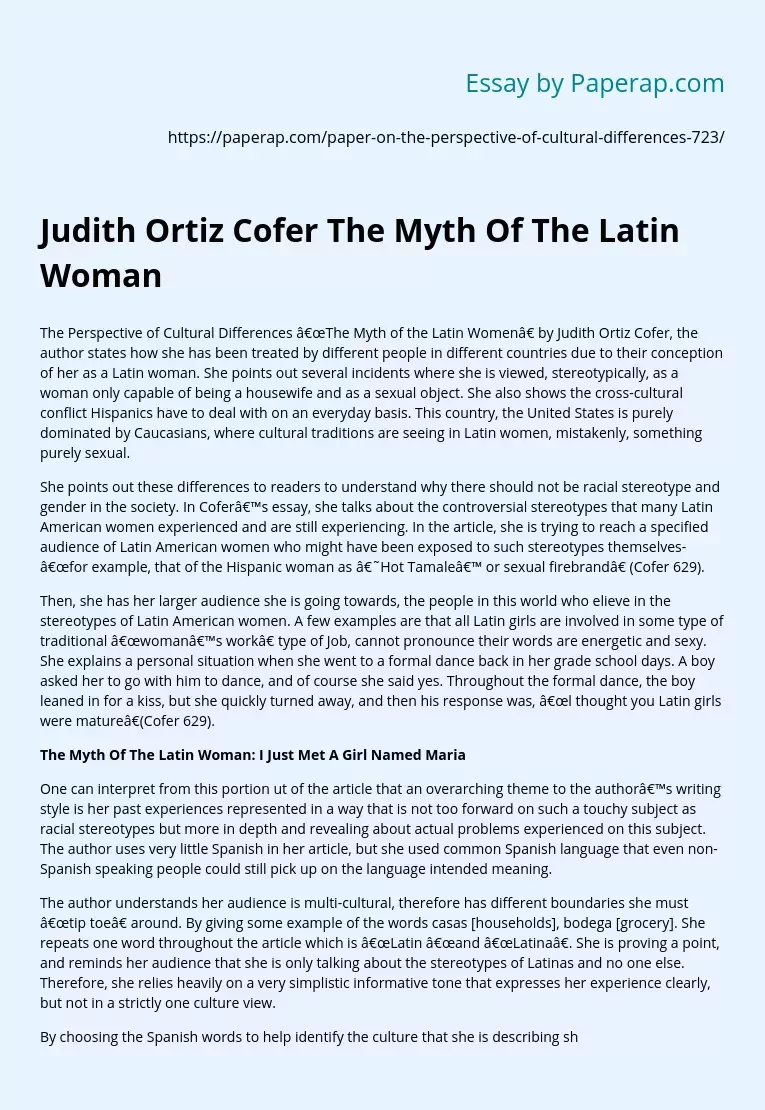Judith Ortiz Cofer The Myth Of The Latin Woman
The Perspective of Cultural Differences “The Myth of the Latin Women” by Judith Ortiz Cofer, the author states how she has been treated by different people in different countries due to their conception of her as a Latin woman. She points out several incidents where she is viewed, stereotypically, as a woman only capable of being a housewife and as a sexual object. She also shows the cross-cultural conflict Hispanics have to deal with on an everyday basis. This country, the United States is purely dominated by Caucasians, where cultural traditions are seeing in Latin women, mistakenly, something purely sexual.
She points out these differences to readers to understand why there should not be racial stereotype and gender in the society. In Cofer’s essay, she talks about the controversial stereotypes that many Latin American women experienced and are still experiencing. In the article, she is trying to reach a specified audience of Latin American women who might have been exposed to such stereotypes themselves-“for example, that of the Hispanic woman as ‘Hot Tamale’ or sexual firebrand” (Cofer 629).
Then, she has her larger audience she is going towards, the people in this world who elieve in the stereotypes of Latin American women. A few examples are that all Latin girls are involved in some type of traditional “woman’s work” type of Job, cannot pronounce their words are energetic and sexy. She explains a personal situation when she went to a formal dance back in her grade school days. A boy asked her to go with him to dance, and of course she said yes.
Throughout the formal dance, the boy leaned in for a kiss, but she quickly turned away, and then his response was, “l thought you Latin girls were mature”(Cofer 629).
The Myth Of The Latin Woman: I Just Met A Girl Named Maria
One can interpret from this portion ut of the article that an overarching theme to the author’s writing style is her past experiences represented in a way that is not too forward on such a touchy subject as racial stereotypes but more in depth and revealing about actual problems experienced on this subject. The author uses very little Spanish in her article, but she used common Spanish language that even non-Spanish speaking people could still pick up on the language intended meaning.
The author understands her audience is multi-cultural, therefore has different boundaries she must “tip toe” around. By giving some example of the words casas [households], bodega [grocery]. She repeats one word throughout the article which is “Latin “and “Latina”. She is proving a point, and reminds her audience that she is only talking about the stereotypes of Latinas and no one else. Therefore, she relies heavily on a very simplistic informative tone that expresses her experience clearly, but not in a strictly one culture view.
By choosing the Spanish words to help identify the culture that she is describing she ties in people outside of that culture as well and does not use too complicated grammar for non-Spanish speakers. She wants to get her point across to the reader to not think of any other stereotypes that might be prevalent in their cultures due to her inexperience in those cultures. The tone that author created in her work has multiple aspects to it. First of all, the theme of her tone is one of serious information that has been compiled out of her past experiences.
However reiterates some of the shameful racist acts she has encountered. Late one evening after the theater, my companion and I listened as the man half-recited, half bellowed “Don’t Cry for me, Argentina. ” (Cofer 630). Readers think this is the most crucial aspect f her tone in the paper, due to the fact that it gives her audience time to move away from dry information, and yet as they hear her story, they can also feel a sense of right and wrong, and how terrible these stereotypes really get. The final piece of tone that one notices is an underlying anger.
She makes clear recollections of many stereotypical experiences right before she ends each one of these, there is a quick statement or interjection of hard, cold, and remembering anger at these terrible experiences and stereotypes. ” In retrospect I understand that my anger gave my eading fire, that I have almost always taken doubts in my abilities as a challenge-and that the result is, most times, a feeling of satisfaction at having won a convert when I see the cold, appraising eyes warm to my words, the body language change, the smile that indicates that I have opened some avenue for communication( Cofer 631).
The author has made an excellent case to why it is desperately important that racial stereotypes be uprooted and forgotten. That she is a proud Latina woman does not mean she is in some narrow minded manner of thinking that would allow one to excuse her in a stereotypical manner. We are who we make ourselves in this world; the author proved that through all the stereotypes and hardships one might experience.
She proved to be a talented, well-educated and expressive writer that represents her life experiences in a relevant method, making one think about the wall of stereotypes that surround these dark bouts of cruelty, which have held together negative cultural boundaries for so long. Works Cited Cofer, Judith Ortiz. “The Myth of the Latin Woman: I Just Met a Girl Named Maria. ” Steps to Writhing Well with Additional Reading. 9th ed. Ed by Jean Wyrick . Boston: wadsworth Cengage, 2014. 625-627.
Judith Ortiz Cofer The Myth Of The Latin Woman. (2019, Dec 05). Retrieved from https://paperap.com/paper-on-the-perspective-of-cultural-differences-723/

